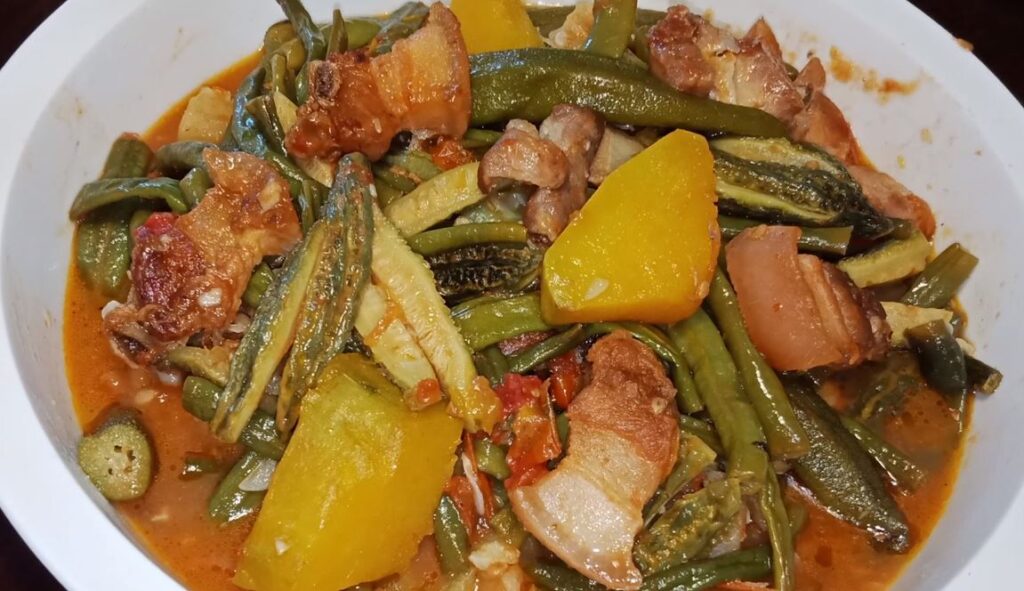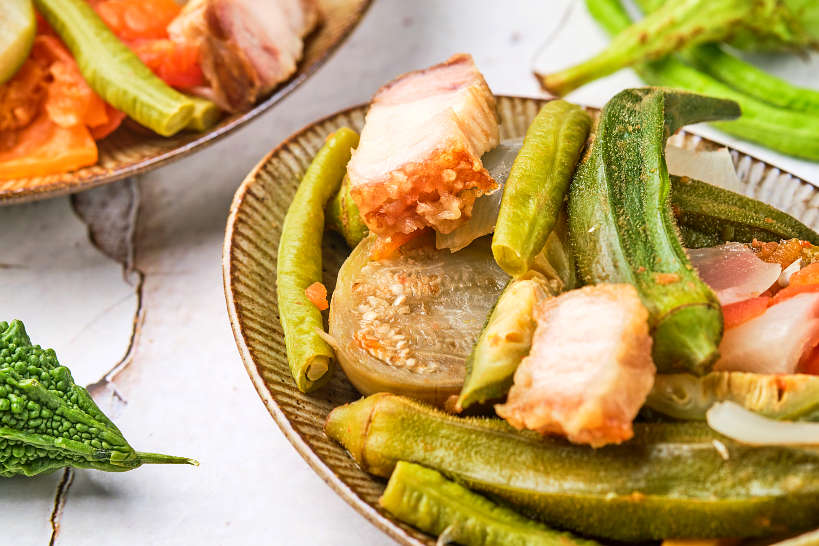Pinakbet: A Culinary Journey Through Ilocano Flavors
Pinakbet: A Culinary Journey Through Ilocano Flavors
Pinakbet: A Culinary Journey Through Ilocano Flavors

Pinakbet, a beloved Filipino dish, is a testament to the ingenuity and resourcefulness of Filipino cooks. This vibrant vegetable stew, with its rich history and diverse regional variations, embodies the essence of Filipino cuisine: simple, flavorful, and deeply rooted in tradition.
A Culinary History:
Pinakbet, derived from the Ilocano word "pinakebbet" meaning "to shrink," is a dish that reflects the Ilocano spirit of making the most of available ingredients. In the past, the dish was often prepared with wild vegetables found in the region, highlighting the resourcefulness of the Ilocano people. Today, pinakbet has evolved, incorporating a wider range of vegetables while retaining its core essence.
The Ilocano Soul of Pinakbet:
The Ilocano version of pinakbet is a true representation of the region’s culinary traditions. It is characterized by its bold, savory flavors, achieved through the use of "bagoong", a fermented shrimp paste that adds a unique umami depth. The Ilocano version also often includes "patis", a fermented fish sauce, further enhancing the savory profile.
Table of Content
The Ingredients:
A typical Ilocano pinakbet features a medley of fresh vegetables, including:
- Okra (Lady’s Fingers): Its slimy texture adds a unique mouthfeel to the dish.
- Eggplant: Provides a soft, absorbent base for the savory sauce.
- Bitter Melon (Ampalaya): Its slightly bitter taste adds a contrasting note to the sweet and savory flavors.
- String Beans (Sitaw): Offers a crunchy texture and adds a touch of sweetness.
- Squashing The Competition: A Comprehensive Review Of The 2023 Vehicle Lineup
- A Cluckin’ Good Ride: A Review Of Pollo Loco’s Chicken Tostada
- The Crispy Verdict: A Review Of RG Fried Chicken Melati
- Coco Ruyuk: The All-Terrain Adventure Machine You Never Knew You Needed
- Beef Dadu Wagyu: A Review Of This Unique And Delicious Breed
- Squash (Kalabasa): Adds a creamy and mild sweetness to the dish.
- Green Papaya (Papaya): Offers a crisp texture and a slightly sweet and tangy flavor.


The Key to Flavor: Bagoong
Bagoong is the heart and soul of Ilocano pinakbet. This fermented shrimp paste, made from small shrimp, undergoes a natural fermentation process, resulting in a pungent, salty, and savory flavor. Bagoong adds a distinct umami depth to the dish, making it truly irresistible.
Regional Variations:
While the Ilocano version is known for its bold flavors, pinakbet has evolved into different regional variations across the Philippines. Some versions may include:
- Pork or Beef: Adding meat adds a richer flavor and protein source.
- Fish: Some versions use fish instead of bagoong, creating a more seafood-forward flavor profile.
- Tomatoes: Adding tomatoes adds a touch of sweetness and acidity.
- Garlic and Onions: These aromatics enhance the overall flavor of the dish.
Preparing Pinakbet:
Making pinakbet is a simple and rewarding experience. Here’s a basic recipe for the Ilocano version:
Ingredients:
- Squashing The Competition: A Comprehensive Review Of The 2023 Vehicle Lineup
- A Cluckin’ Good Ride: A Review Of Pollo Loco’s Chicken Tostada
- The Crispy Verdict: A Review Of RG Fried Chicken Melati
- Coco Ruyuk: The All-Terrain Adventure Machine You Never Knew You Needed
- Beef Dadu Wagyu: A Review Of This Unique And Delicious Breed
- 1 cup bagoong alamang (fermented shrimp paste)
- 1 cup water
- 1 large eggplant, diced
- 1 cup okra, sliced
- 1 cup string beans, cut into 1-inch pieces
- 1 cup squash, cubed
- 1 cup green papaya, diced
- 1/2 cup patis (fish sauce)
- Salt and pepper to taste
Instructions:
- In a large pot, combine the bagoong and water. Bring to a simmer and cook for 5 minutes, stirring occasionally.
- Add the eggplant, okra, string beans, squash, and green papaya to the pot.
- Add the patis and season with salt and pepper to taste.
- Bring the mixture to a boil, then reduce heat and simmer for 15-20 minutes, or until the vegetables are tender.
- Serve hot with rice.
Tips for a Perfect Pinakbet:
- Use fresh vegetables: Fresh vegetables ensure a vibrant flavor and crisp texture.
- Don’t overcook the vegetables: Overcooked vegetables will become mushy.
- Adjust the amount of bagoong and patis to your taste: Start with a smaller amount and adjust as needed.
- Serve with rice: Rice is the perfect accompaniment to the flavorful and savory pinakbet.
Beyond the Plate:
Pinakbet is more than just a delicious dish; it’s a culinary journey through Ilocano flavors. It represents the ingenuity and resourcefulness of the Ilocano people, who have turned humble ingredients into a truly unique and flavorful culinary experience.
Pinakbet: A Culinary Legacy:
Pinakbet continues to be a cherished dish in Filipino homes and restaurants. Its simple yet flavorful preparation, combined with its versatility and adaptability, has ensured its enduring popularity. As a testament to the rich culinary heritage of the Philippines, pinakbet stands as a symbol of tradition, ingenuity, and the enduring power of food to bring people together.
Beyond the Recipe:
The story of pinakbet is not just about the ingredients and the cooking process. It’s also about the stories and traditions that surround it. It’s about the generations of Ilocano cooks who have passed down their knowledge and love for this dish. It’s about the shared meals and laughter that accompany a plate of pinakbet.
A Culinary Journey:
The next time you enjoy a plate of pinakbet, take a moment to appreciate the journey that each ingredient has taken. Consider the hands that harvested the vegetables, the generations of cooks who have perfected the recipe, and the stories that have been shared around the table. Pinakbet is more than just a dish; it’s a culinary journey through the heart of Filipino culture.
A Culinary Heritage:
Pinakbet is a dish that celebrates the bounty of the land and the ingenuity of the Filipino people. It’s a dish that brings families and communities together, and it’s a dish that will continue to be enjoyed for generations to come.
A Culinary Invitation:
So, the next time you’re looking for a delicious and satisfying meal, try making pinakbet. It’s a simple dish to prepare, but it’s packed with flavor and history. You’ll be surprised at how much you enjoy this culinary journey through Ilocano flavors.
sure
Thus, we hope this article has provided valuable insights into Pinakbet: A Culinary Journey Through Ilocano Flavors. We thank you for taking the time to read this article. See you in our next article!
Posting Komentar untuk "Pinakbet: A Culinary Journey Through Ilocano Flavors"